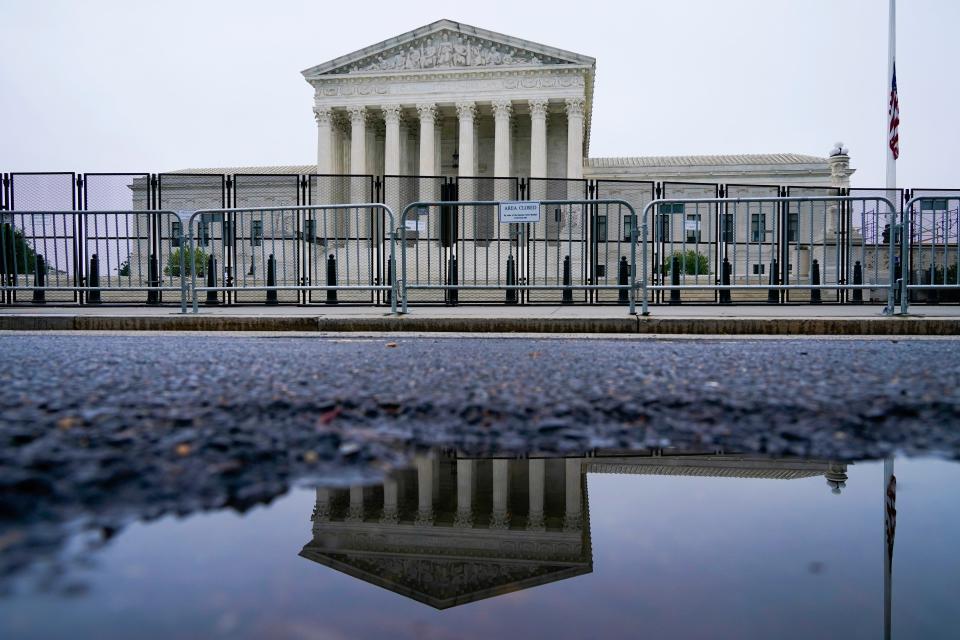I defend the First Amendment, but don't protest outside the Supreme Court justices' homes
This opinion column is not about abortion. This column is about the First Amendment, something I have defended in court for decades. I love the First Amendment and the right to free speech, regardless of whether I personally agree with anyone’s grievances.
I have defended the First Amendment rights of nuns to chain themselves to the White House fence; a woman who, while protesting nuclear weapons, wore a wig with tinfoil under it to prevent the CIA from communicating with her by passing Metro buses; activist Mitch Snyder protesting homelessness; the child-rearing expert Dr. Benjamin Spock and his wife protesting nuclear war; and many other Americans seeking redress from their government and wanting their voices to be heard.
The reason why they protested was never the issue – it was about their right, and all our rights, to speak freely.
I have also traveled to and reported from many countries such as North Korea, China, Cuba and Myanmar, where citizens do not have this freedom to peacefully protest. The stark contrast is breathtaking.
We need free speech. But don't harass the justices.
For more than a week, protesters have congregated outside of the private homes of Supreme Court Justices Samuel Alito, Brett Kavanaugh and Amy Coney Barrett and Chief Justice John Roberts to protest an as-of-yet undecided court case.

Protesters have at various points reportedly used obscenities and been confrontational. Is this form of protest, at a private jurist’s home, a First Amendment right and protected free speech? Or not?
The Supreme Court: Our mom, Sandra Day O'Connor, knew something about politics that America forgot
A federal law, statute 18 U.S. Code Section 1507, could broadly allow the arrest of protesters. The law makes it a misdemeanor to, among other things, picket or protest or parade near a court or residence occupied or used by judge, juror or witness with intent to influence the outcome of a case. Our justice system has a tradition of abhorring witness tampering and intimidation – or any outside efforts to sway a court verdict.

Threats and intimidation have historically been more of an issue with witnesses and jurors. Although two years ago, an armed man upset with a postponement in his legal case, and with women, appeared at the door of a female federal judge’s home in New Jersey and shot and killed her son and gravely injured her husband. Four federal judges have been killed since 1979, and, according to NPR, nearly 4,500 threats and “inappropriate communications” were directed against federal judges in 2019.
Today, there are calls to enforce the federal law against picketing and protesting in part because the justices have spouses and in some cases children in their homes. Either a crowd or a lone individual could become violent.
Great Replacement Theory?: Try language of death wielded by opportunistic right-wing figures
Many of the justices’ neighbors also do not appreciate having their local streets become overwhelmed by both protesters and the necessary heavy security response. They, too, have lives and families: Streets that only a few weeks ago were bustling with children happily playing outside have gone silent except for the constant hum of large security vehicles.
What if the protests were outside of liberal justices' homes?
The U.S. Department of Justice needs to decide whether it will enforce this law for another reason: Selective enforcement of criminal violations predicated on politics is extremely dangerous to a democracy. Would those defending these protesters also fervently agree that Second Amendment activists have the same right to demonstrate in the same manner in front of the homes of Justices Sonya Sotomayor or Elena Kagan? Is this the atmosphere for how we want our Supreme Court – or any court’s – deliberations to be conducted?
Pro-life Women: Meet the women working to overturn Roe v. Wade and restrict abortions across America
If, however, the future of First Amendment demonstrations turns on enforcement of this otherwise previously obscure federal code, in many respects, we will have all lost. Anger and vitriol will be the true victors. Incumbent upon all of us who cherish free speech is to ask the question: Just because you can, should you? And at what cost?
What a breath of fresh air it would be if leaders in the pro-abortion rights movement took to the airwaves and social media and asked the protesters to focus on public spaces, such as the Supreme Court building or even Congress and the White House. Their points would be made, news organizations would cover it and, yes, the First Amendment would remain intact.
Greta Van Susteren is the host of "Full Court Press." She is also a former television news anchor for CNN, Fox News and MSNBC. Follow her on Twitter: @greta
You can read diverse opinions from our Board of Contributors and other writers on the Opinion front page, on Twitter @usatodayopinion and in our daily Opinion newsletter. To respond to a column, submit a comment to letters@usatoday.com.
This article originally appeared on USA TODAY: Abortion protests: Supreme Court justices' homes vs. First Amendment

 Yahoo Movies
Yahoo Movies 
